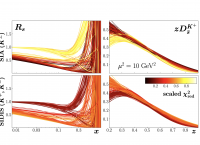See below for highlights of hadronization and fragmentation functions from JAM. Click images for enlargement
SIMULTANEOUS MONTE CARLO ANALYSIS OF PARTON DENSITIES AND FRAGMENTATION FUNCTIONS
The JAM (Jefferson Lab Angular Momentum) collaboration has performed a comprehensive new Monte Carlo analysis of high-energy lepton-lepton, lepton-hadron and hadron-hadron scattering data to simultaneously determine parton distribution functions (PDFs) in the proton and parton to hadron fragmentation functions (FFs). Employing a new multi-step fitting strategy and more flexible parametrizations for both PDFs and FFs, the study assesses the impact of different data sets on sea quark densities and confirms the previously observed suppression of the strange quark distribution. The new fit will allow for improved studies of the universality of parton correlation functions, including transverse momentum dependent (TMD) distributions, across a wide variety of processes, as well as the matching of collinear to TMD factorization descriptions.


